Why Is My Goldendoodle’s Hair Turning White: Aging or Health Issue?
Is your beloved Goldendoodle’s hair turning white? This intriguing phenomenon is more common than you might think. In this article, we’ll explore the various reasons behind the whitening of your Goldendoodle’s coat, from genetics to health factors. Whether it’s a natural part of aging or something more, understanding why your dog is experiencing this change can help you ensure their well-being. Join us as we explore into the world of Goldendoodle coat transformations!
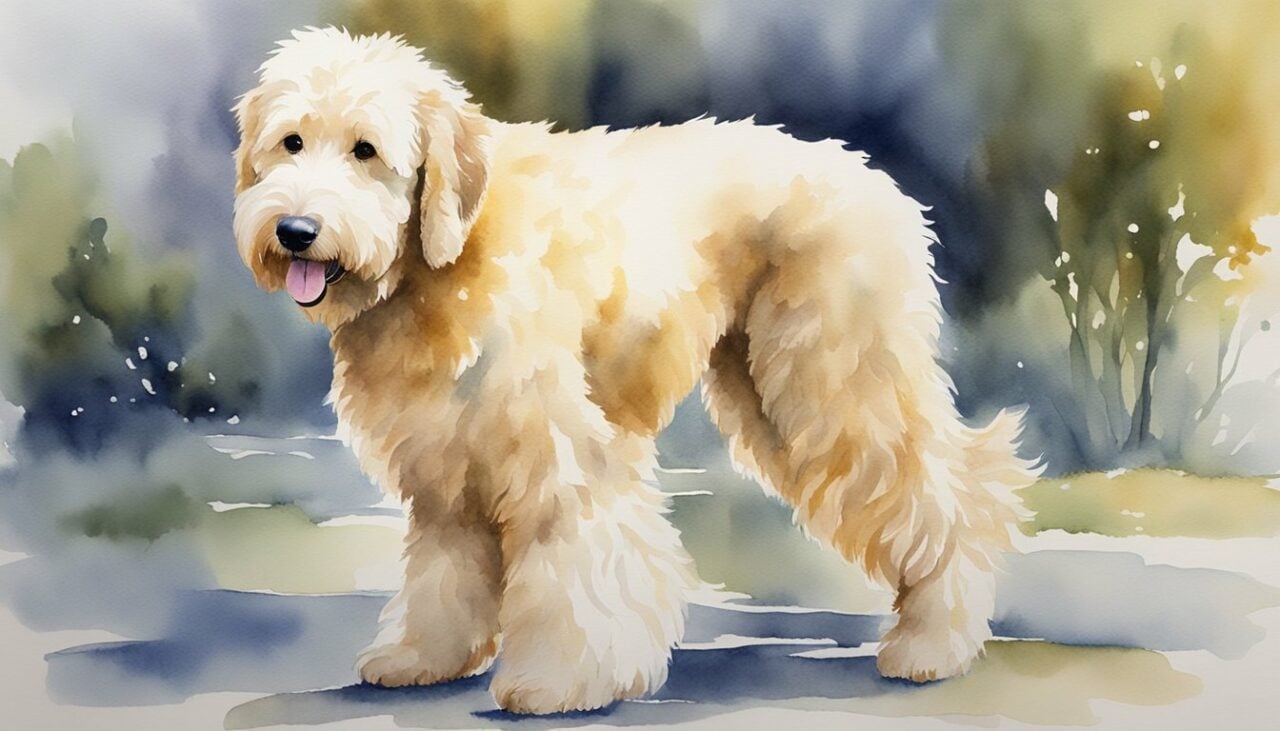
Understanding Coat Color Changes in Goldendoodles
As a mini Goldendoodle owner, I’ve observed that coat color transitions are not uncommon in this breed. Goldendoodles can experience color changes in their fur due to a variety of factors, one of which is fading as they mature. This phenomenon is often referred to as “fading” or pigment loss.
- Puppy to Adult: The goldendoodle coat evolves from puppyhood to adulthood. This shift generally begins around 4-8 months of age. Initially, Lexie, my own dog, had a dark apricot hue as a pup, which has since softened to a creamier shade over the years.
- Genetics: The genetics inherited from the Poodle side can contribute to gradual lightening. This is usually a normal process where the darker puppy fur is replaced with a lighter adult coat, sometimes culminating in fur that’s turning white.
- Grooming Impact: Trimming or grooming your Goldendoodle might also unveil a lighter color, as the fur closer to the root is often not as deeply pigmented.
It’s important to understand that while fur lightening is often natural, sudden or patchy color changes should be discussed with a veterinarian. These could be indicative of other health issues.
In my experience, Lexie’s coat transition was gradual and more pronounced after grooming sessions. Maintaining a neutral and knowledgeable perspective helps to properly manage expectations of a Goldendoodle’s coat color evolution. They remain the same wonderful companions, regardless of the color they flaunt.
Factors Influencing Changes in Fur Color
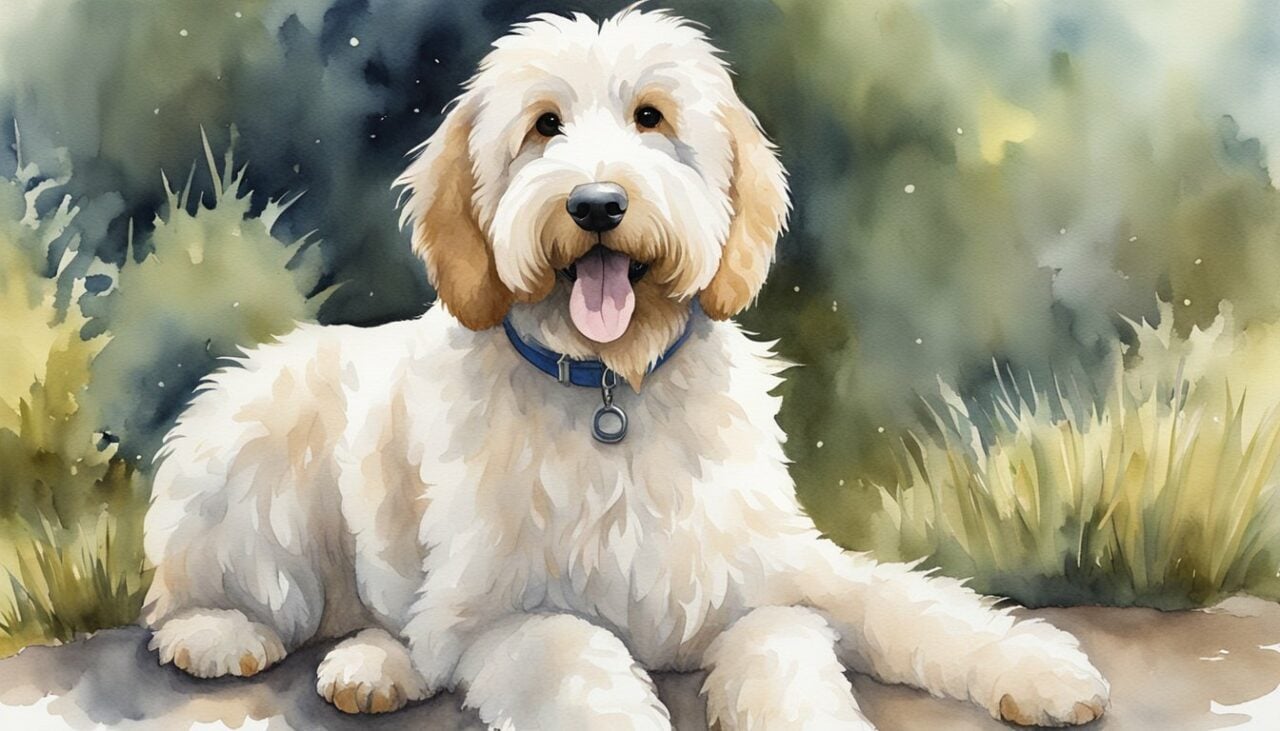
As Lexie, my 8-year-old mini Goldendoodle, began to display changes in her fur color, I started researching to understand the contributing factors. I discovered that genetics, aging, and health conditions play significant roles in the pigmentation of Goldendoodle coats.
Genetic Influences on Coat Color
The pigmentation of Goldendoodle fur is strongly tied to their genetic makeup, which they inherit from their Poodle and Golden Retriever lineage. As a hybrid breed, Goldendoodles inherit a complex genetic code that determines their coat color.
The fading or lightening of the coat, such as Lexie’s fur transitioning to white in some patches, can be a hereditary trait coming from the Poodle side, known for their coats that may lighten as they mature. The changing shades of cream, apricot, or gray can be rather unpredictable due to this genetic diversity.
Effect of Aging on Goldendoodle Coats
The aging process is a natural progression that can affect the color of a Goldendoodle’s coat. Puppies are born with a certain coat color, which may change as they grow older and lose their puppy fur.
Just like humans can go gray as they age, dogs like Lexie may see their fur turn white or gray, which is a normal part of aging. When I first noticed a few white hairs on Lexie’s muzzle, I realized that time was indeed having an effect on her once deep apricot coat.
Health Conditions Impacting Fur Pigmentation
Several health conditions can lead to changes in fur color. For instance, hypothyroidism is a common disorder among dogs that can cause the fur to become dull and later turn white.
Another possible health-related cause for pigmentation changes is vitiligo, a skin condition that leads to loss of color in patches. A vet can rule out serious concerns, but it was a reminder that changes in fur color might be a sign of an underlying health issue and should not be overlooked.
Identifying Common Signs of Aging in Goldendoodles
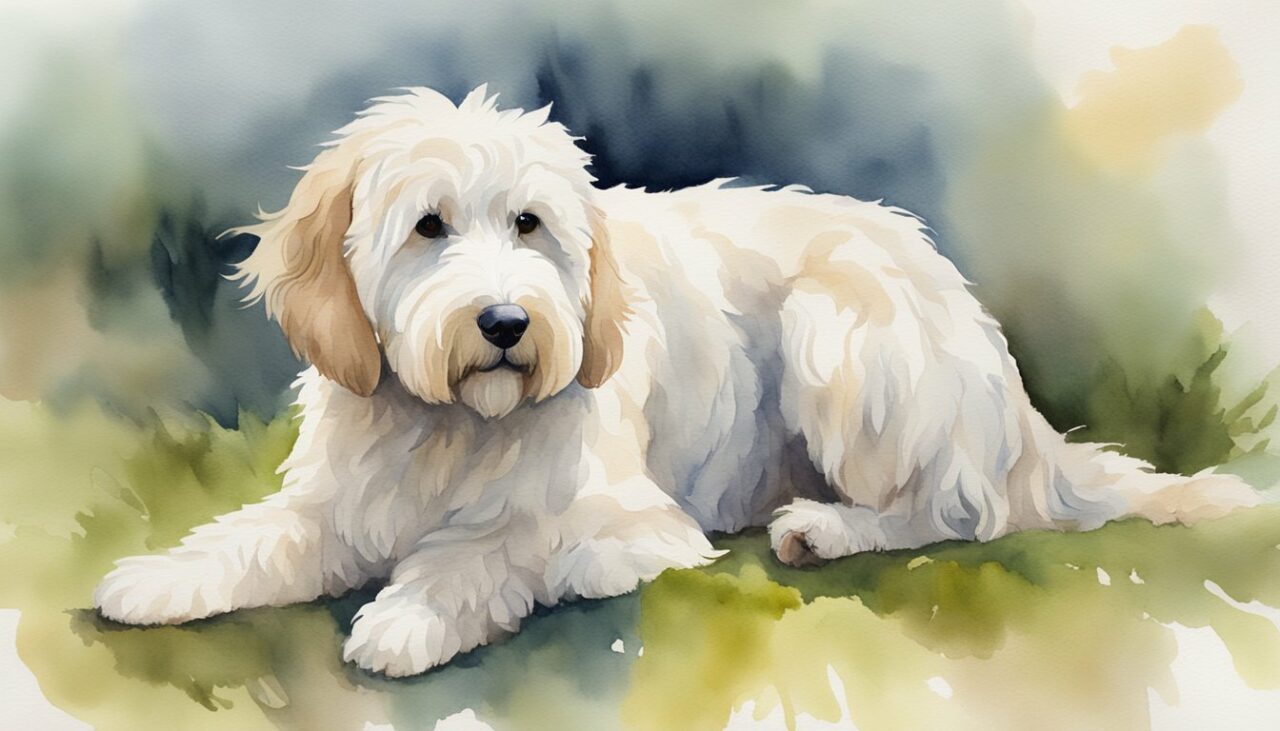
As a mini Goldendoodle owner, I’ve observed firsthand how our furry friends begin to show age-related changes as they move into their senior years.
One of the most noticeable signs in my Lexie, who is now an 8-year-old mini Goldendoodle, is the transformation of her fur color. It is a common occurrence in aging Goldendoodles.
- Adult Coat: Goldendoodles gradually lose their puppy coat as they mature, which often transitions into a thicker adult coat with different shading.
- Aging Process: The aging process itself can result in fading fur color, leading to a more pronounced white or grey appearance especially around the muzzle and eyes.
- White and Grey Hairs: Even the most lustrous Goldendoodle coat will succumb to the emergence of white and grey hairs as part of the aging process, which is totally normal.
In Lexie, I’ve also noticed a decrease in her activity levels, which, in conjunction with her coat changing, signaled that she was entering her older years. Moreover, changes to her coat aren’t just limited to color. The texture and thickness may alter, too. Fortunately, age-related changes to her coat color don’t necessarily indicate any health issues.
However, it’s important to consider other factors that aren’t a natural part of aging. For instance, environmental factors (like sun exposure) and health issues (such as hypothyroidism) can also cause a coat to lighten.
Seeing our dogs muzzle start to turn a snowy white is a bittersweet reminder of the many years we’ve shared. To ensure that these changes are simply due to aging, regular vet visits are essential for maintaining her health.
Environmental and External Factors Affecting Coat Color
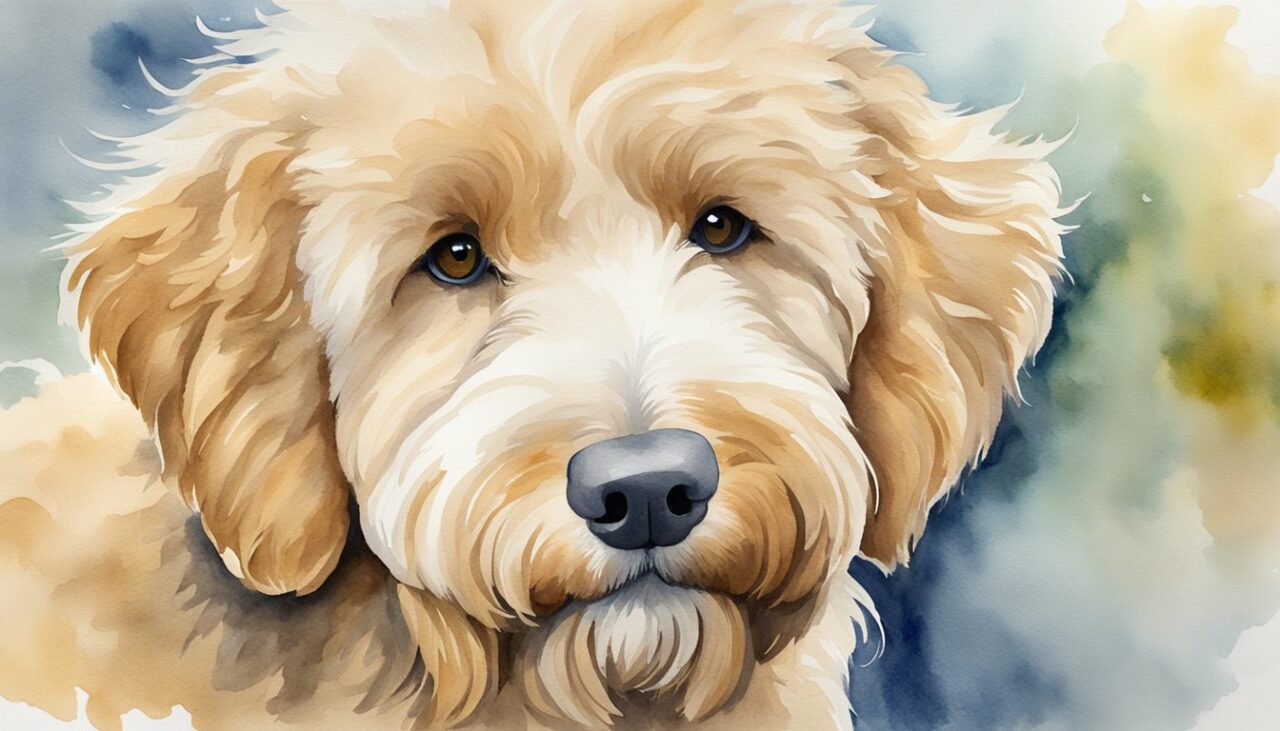
Several environmental elements and external factors can have a significant impact on the coat color of goldendoodles like my Lexie. These influences can range from the effects of sun exposure to the role of diet and stress in altering fur pigmentation.
Impact of Sun Exposure on Fur
Sunlight plays a major role in affecting the color of a goldendoodle’s coat. Similar to how human hair may lighten with prolonged exposure to the sun, a goldendoodle’s fur can undergo a process called sun bleaching.
This is particularly noticeable during the summer months when dogs spend more time outdoors. In my experience with Lexie, I’ve noticed her coat turns a lighter shade after our summer beach trips.

Stress and Anxiety Related Color Changes
Changes in fur color can also be associated with stress and anxiety. High stress levels can cause changes in the skin and fur of dogs, leading to what’s often referred to as “stress graying.” This is usually seen around the muzzle and face.
Stress doesn’t just impact behavior; it can have tangible effects on a dog’s appearance as well.
Diet and Nutrition’s Role in Coat Health
Diet and nutrition are critical for maintaining a healthy coat. Deficiencies in essential vitamins and minerals can lead to color changes and affect coat texture.
Feeding a balanced diet rich in omega fatty acids and other nutrients can help maintain the vibrant color and luster of a goldendoodle’s coat. I make sure Lexie’s diet is balanced with high-quality dog food enriched with all the necessary nutrients to keep her coat as colorful as her personality.
Goldendoodle Grooming and Coat Maintenance
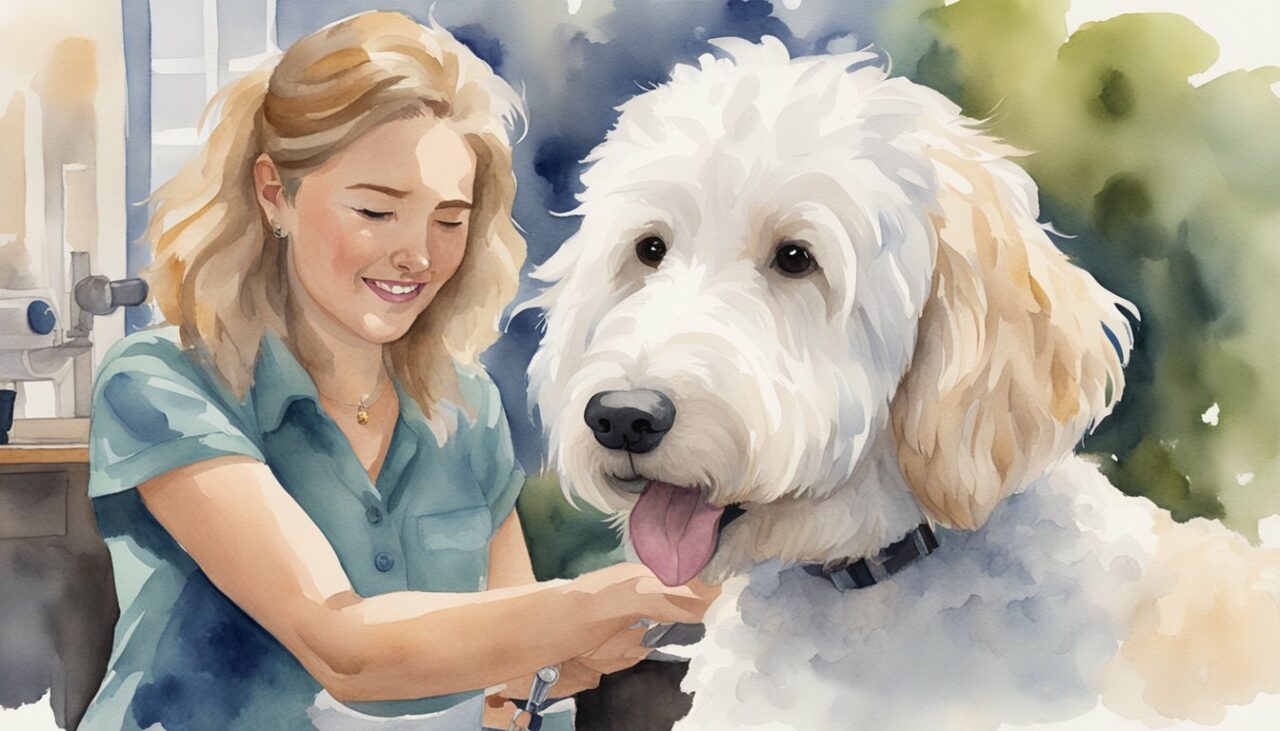
Keeping a Goldendoodle’s coat lustrous and healthy requires consistent and proper grooming practices. This section will outline effective brushing techniques, how to deal with matting and tangles, and best practices for bathing and overall coat care.
Proper Brushing Techniques
Proper brushing is not only essential for a Goldendoodle’s appearance but also for their overall skin health. I use a slicker brush to effectively detangle and remove loose hair. It’s important to be gentle and thorough, brushing in the direction of hair growth to avoid discomfort. My Lexie particularly enjoys her brushing sessions when I use slow, calming strokes.
- Start from the head and move towards the tail
- Gently brush in sections to ensure no area is missed
- Use a slicker brush for daily grooming
Dealing with Matting and Tangles
Mats and tangles can be uncomfortable for your Goldendoodle, so frequent checks are important, particularly behind the ears and under the legs where matting often occurs.
For any mats that develop, I carefully use a dematting comb to work them out without hurting Lexie. If matting is too severe, it’s best to seek professional grooming help rather than risking discomfort or injury to your dog.
- Check for mats daily during brushing
- Use a dematting comb or tool designed for mats
- Never pull or tug harshly on the mats
Bathing and Coat Care
Bathing is a critical component of Goldendoodle coat maintenance, but it should not be overdone as it can dry out their skin.
I bathe Lexie once every four to six weeks using a dog-formulated shampoo that helps retain her coat’s natural oils. After baths, it’s crucial to thoroughly dry their coat to prevent any dampness that can lead to skin irritation or matting.
- Bath every 4-6 weeks with a mild dog shampoo
- Thoroughly dry your Goldendoodle after each bath
- Regularly check the skin for any signs of irritation or infection
I always ensure to gently blow dry Lexie’s coat to avoid any chill, especially during colder months.
Genetics and Goldendoodle Coat Varieties
As a seasoned mini Goldendoodle owner, I’ve noticed that the variety in coat color and texture of these adorable dogs is rooted deeply in their genetics. Let’s unpack the intricacies of these traits and understand why some Goldendoodles, like my Lexie, exhibit changes in their coat over time.
Poodle and Golden Retriever Heritage
Goldendoodles are a blend of two distinct breeds: the elegant Poodle and the friendly Golden Retriever. Genetically, they inherit diverse coat colors and textures from their parent breeds, including cream, apricot, red, chocolate, and black. Poodles specifically carry genetics for a variety of colors like white, silver, and gray, and these can manifest in their Goldendoodle offspring.
Understanding Coat Textures and Colors
The texture of a Goldendoodle’s coat can mirror the Poodle’s tight curls or the Golden Retriever’s straight, wavy fur. Commonly, the mixture results in a soft, wavy texture that can range in colors including white, silver, gray, black, brown, apricot, red, and cream.
From my experience with Lexie, her coat appeared to be a luscious, warm cream color during her younger years but has gotten progressively lighter with age.
Inheritance of White and Silver Coats
Coat color dilution, which can turn Goldendoodle coats lighter shades like white or silver, is a fascinating result of genetics.
This can happen due to the expression of certain dilution genes inherited from the Poodle. Additionally, as Goldendoodles age, they may develop more white or silver hairs, similar to humans going gray.
Lexie, for instance, started showing signs of light silvering around her muzzle when she turned seven, a change that has been gradual and gave her a distinguished look. This color evolution underscores the complexity and unpredictability of the genetics behind Goldendoodle coats.
Puppy to Adult: Coat Transition in Goldendoodles
As a mini Goldendoodle owner, I’ve observed the transition of my dog Lexie from a fluffball puppy to a mature adult with a distinct coat. Goldendoodle puppies are often born with soft, wavy puppy coats that endear them to anyone. But these coats are not permanent. As they grow older, these puppy coats begin to change, paving the way for their adult fur.
Goldendoodles, a charming crossbreed of Golden Retrievers and Poodles, have a unique mix of coat types that can range from curly to straight.
The adult coat typically starts to come in at around six to twelve months of age. During this coat transition, owners might notice the puppy coat matting more easily and should adjust their grooming routines accordingly.
- Puppy coat: Silky, soft, and light-colored
- Adult coat: Denser, coarser, and may darken or lighten in color
Here are some key points to remember during the transition:
- Increase brushing frequency to avoid mats, especially:
- Under ears
- At the armpits
- Use the right tools, such as slicker brushes or special combs for Goldendoodle coats.
- Prepare for possible shedding, which may surprise some owners expecting a non-shedding breed. I remember finding small clumps of Lexie’s soft puppy coat around the house when she was in transition.
Understanding that these changes are normal will help you provide the best care for your Goldendoodle’s evolving coat. Adapt your grooming techniques and celebrate each stage of your Goldendoodle puppy coat transition to maintain their beautiful adult coat.
Health Screening and Veterinary Care for Coat Changes
If you notice changes and are concerned, it is always a good idea to seek a veterinarian’s advice to determine if there are any underlying health issues.
Health Screenings: Regular health screenings are essential for detecting early signs of illness that might affect your dog’s coat. These screenings can include blood tests, skin scrapings, and thyroid function tests to check for any imbalances or skin conditions.
Diet and Nutrition: A balanced diet plays a significant role in the health of a dog’s coat. If your Goldendoodle is experiencing coat-related issues, it’s important to evaluate their diet. Make sure they are receiving all the necessary vitamins and minerals.
This might involve introducing supplements or adjusting their food. When Lexie’s coat started to change, I discussed her diet with the vet, who recommended some dietary adjustments to ensure she was getting enough omega fatty acids.
Veterinary Care: If a skin condition or illness is identified, your vet may prescribe medication to treat the issue. In some cases, changes in coat color can be symptomatic of more serious conditions like hypothyroidism, which requires medication for management.
When Lexie’s tests came back, it was determined that stress might have been a contributing factor to the color change in her coat.
It’s crucial to consult with a veterinarian promptly if you notice any changes in your Goldendoodle’s coat or overall health. By doing so, you can provide the best care possible for your furry friend’s specific needs.
The Connection Between Coat Color and Dog Behavior
When observing my mini Goldendoodle, Lexie, through the years, I’ve noticed that not only has her jubilant character been consistent, but so has her coat’s lightening over time.
Speaking generally, the dogs’ coat color itself isn’t a direct indicator of behavior changes; however, the factors that influence coat color, like stress or anxiety, can correlate with shifts in behavior.
It’s important for fellow dog owners to note potential changes in behavior which could signify underlying health concerns that manifest in coat color changes, as discussed in links about how Vitiligo and hypothyroidism may lead to a lighter coat.
- Behavior: Altered behavior could stem from internal conditions affecting coat color.
- Stress & Anxiety: May accelerate the whitening of the coat, implying a need for veterinary attention.
- Friendliness: Unchanged social behavior suggests a healthy dog with natural aging-related color changes.
As a confident and knowledgeable Goldendoodle owner, I maintain that while coat color changes may accompany behavioral shifts, they’re more often than not a sign of natural aging. Monitoring Lexie has reinforced my understanding that health-related behavioral changes are occasional, while a gradual lightening of her coat is just part of her growing older gracefully.